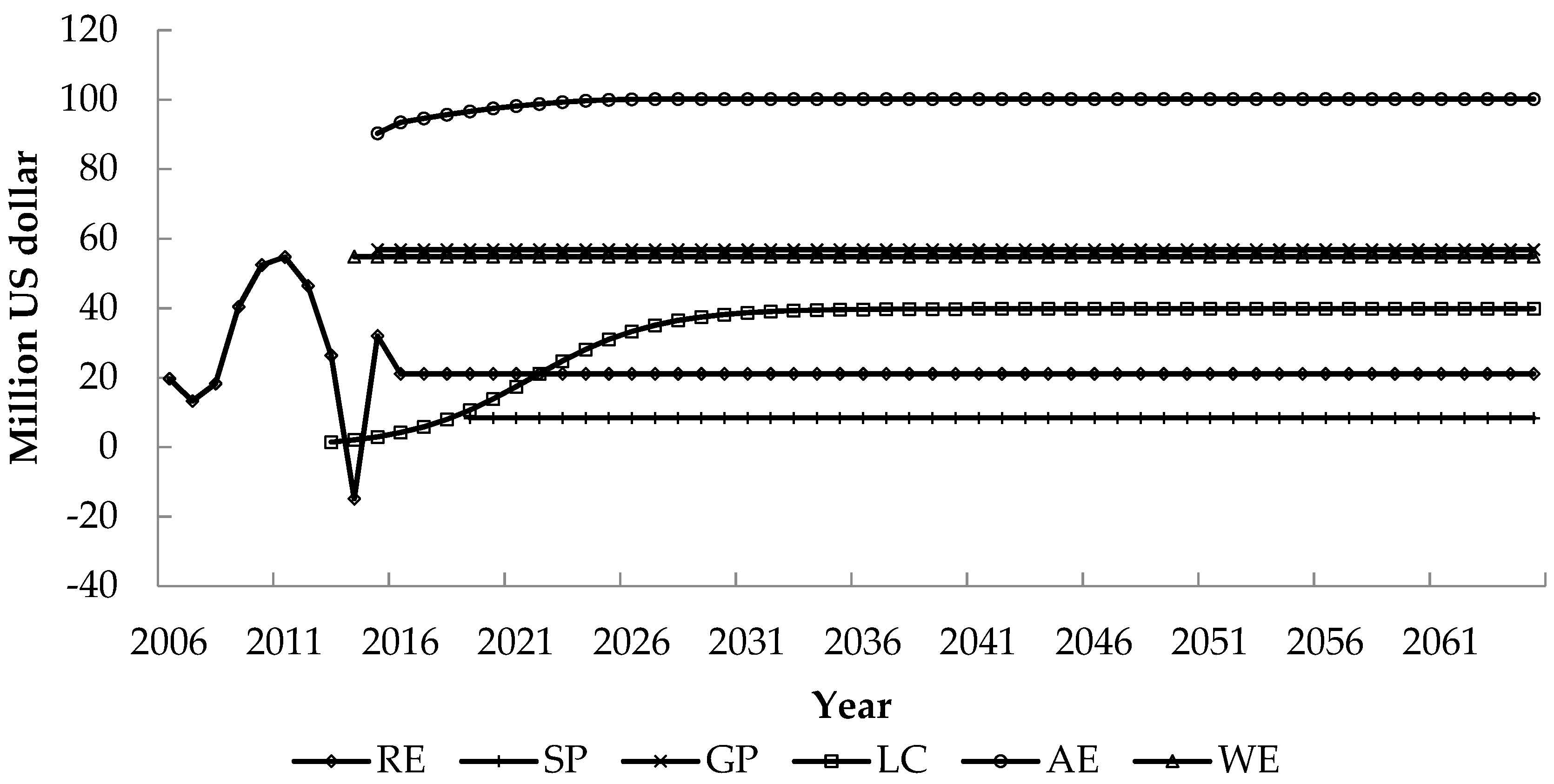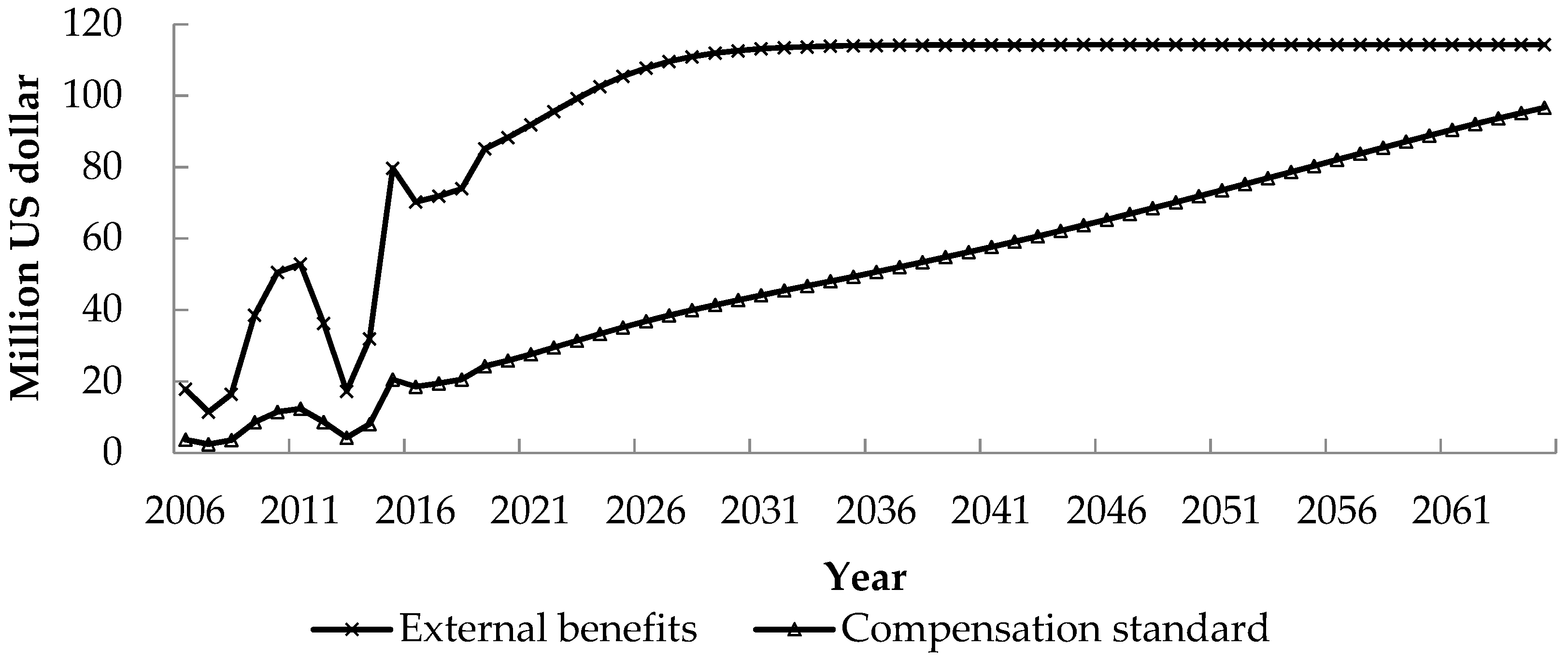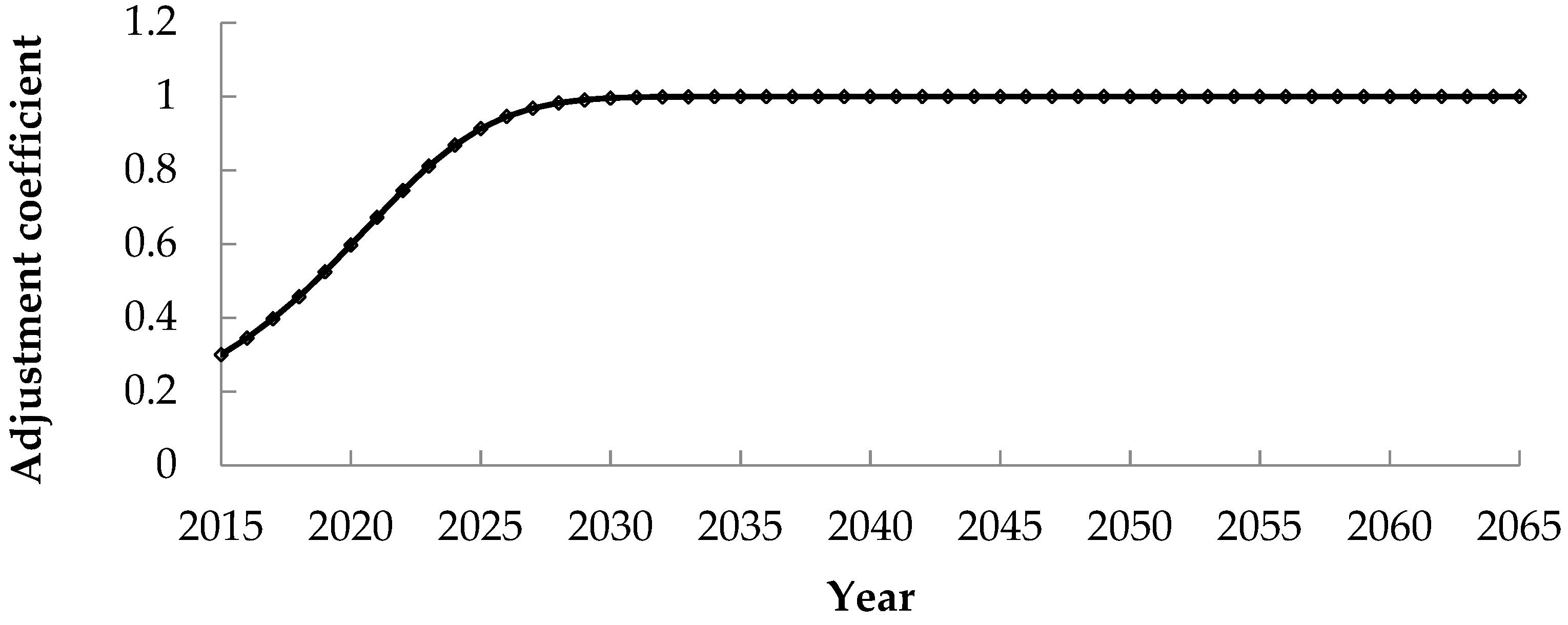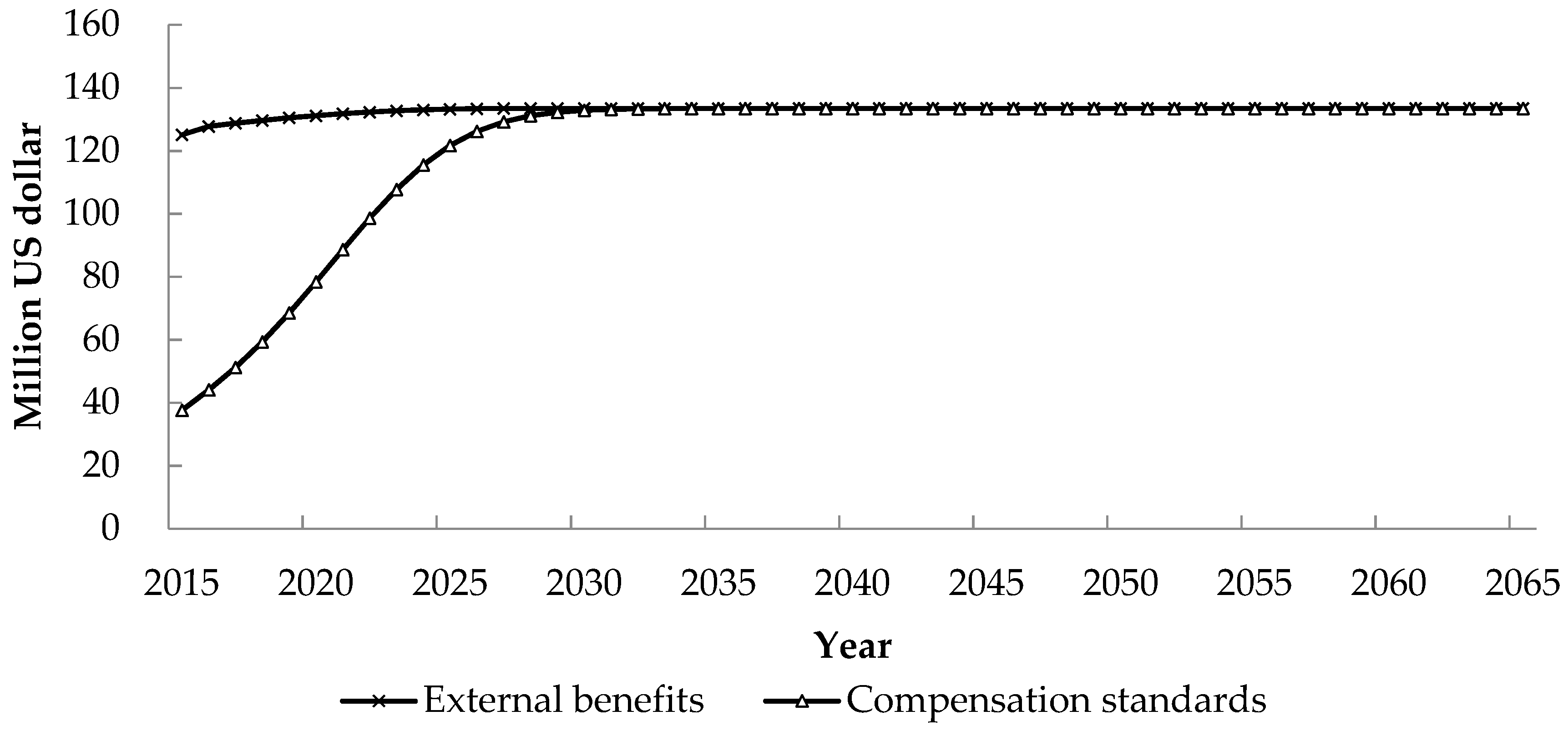1. Introduction
The installed capacity of hydropower in China has exceeded 350 GW and the annual hydropower generation has exceeded 120 TWh, and both of which are ranking the first in the world [
1]. However, with the rising difficulty of resettlement, the increasing pressure on ecological protection, and the declining economic efficiency of hydropower development, the competitive advantage of hydropower in the energy market is getting smaller and smaller. Furthermore, as a clean and renewable energy, the preferential access of hydropower to the grid has not been guaranteed by national laws and systems, and the abandonment of hydropower is a serious problem in China [
2]. How to deal with the plight faced by hydropower development, how to further mitigate the social and ecological problems caused by hydropower development, how to guarantee the healthy, orderly, and sustainable development of hydropower, and how to realize the environment friendly, benefit sharing goal of hydropower development, are the problems urgently need to be solved in the new era.
Scholars around the world have tried to solve these problems. Costanza (1997) estimated the economic value of 17 ecosystem services for biomes [
3], and based on these values, other scholars used the payment for ecosystem services (PES) [
4,
5] or the ecological compensation [
6,
7,
8] to internalize the external impacts on the environment by hydropower development. Fan Qixiang (2010) established a benefit-sharing model based on the values of resources and the theory of land rent to solve the resettlement problems [
9]. Shrestha (2016) summarized the benefit-sharing mechanisms in Nepal into five types and provided specific recommendations for each type of mechanism [
10]. Branche E. (2017) constructed a “sharing” concept to maximize the benefits of multi-functional hydropower projects such as power generation, water supply, entertainment, ecological services, and economic growth through vision sharing, resource sharing, responsibility sharing, rights and risks sharing, as well as cost and benefit sharing among stakeholders [
11]. Rayamajhee (2018) designed an endogenous externality mitigation fund based on local negotiations, which is directly used to compensate individuals affected by specific environmental externalities, to replace the one-off tax policies and measures to include external costs in energy prices [
12].
However, these studies are mainly focused on the negative impacts of hydropower development, and only emphasized the benefit sharing by hydropower development enterprises. While the studies on positive impacts are a few, and even fewer on the internalization of positive impacts, such as optimizing the energy structure, improving the atmospheric environment and stimulating the economic development. These positive impacts are enjoyed by beneficiaries free of charge. Facing with the plight of hydropower development, it is impossible for hydropower development enterprises to deal with the above problems alone, so the beneficiaries of hydropower development shall also share their external benefits. In this paper, the theory of externality is introduced into the evaluation of hydropower development, the external benefits brought by hydropower development are defined and measured, the external beneficiaries are identified and their compensation standards are calculated. The internalization model established can help to improve the traditional benefit sharing mechanism by allowing the beneficiaries of hydropower development besides the enterprise developing the project to share their external benefits. In this way, the benefits of hydropower development including the internal and external benefits can be properly distributed, the pressure on hydropower development enterprise can be relieved, and those poorly affected can be further compensated, which will lay a solid foundation for the coordinated and sustainable development of hydropower development.
3. Results
The Z hydropower development project on JS River in Sichuan Province and Yunnan Province is chosen as the case to evaluate its external benefits and their internalization. The data used are collected from the Feasibility Study Report, the Environment Impact Assessment Report of Z Hydropower Station, China statistical information network, and websites of relevant statistical bureaus and governments.
3.1. External Benefits Brought by the Z Hydropower Development
The development of the Z hydropower project brought vast external benefits, as shown in
Figure 1. The external benefit of shipping performance upgrading is the smallest, while the external benefit of atmospheric environment improvement is the largest.
The benefit of regional economy stimulation will manifest at the beginning of the project construction in 2006, it changes with the project investment and the working intensity during the construction period, and even drops to a negative benefit in 2014 due to the reduction of investment during the completion period, but remains constant at 21 million US dollars after the normal operation of the project. The benefit of shipping performance upgrading is 8 million US dollars/year on average, which will manifest after the readiness of the 24 h uninterrupted navigation capacity in 2019. The benefit of grid performance improvement is 57 million US dollars/year on average, which will manifest after the normal operation of the hydropower project in 2015. The benefit of local climate regulation manifests gradually in accordance with the biological growth pattern, and reaches to a new balance of 40 million US dollars in 2039. The benefit of atmospheric environment improvement manifests after the supply of clean power to the power receiving area in 2015. With the reducing of carbon dioxide emission from the reservoir and the reduction of carbon dioxide and sulfur dioxide emission due to the replacement of thermal power plants, this external benefit gradually increases from 90 million US dollars in 2015 to 701 million US dollars in 2026, and then tends to be constant. The benefit of water environmental capacity improvement is 55 million US dollars/year on average, which will manifest after impoundment to the normal water level in 2014.
3.2. Internalization of External Benefits Brought by the Z Hydropower Development
The beneficiaries of positive externalities of the Z hydropower development are mainly distributed in the surrounding areas, downstream areas of the dam and the power receiving areas. The surrounding areas of the Z hydropower project are mainly A county of C city in Yunnan Province and B county of D city in Sichuan Province. The downstream area is mainly D city. Due to the overlap between the surrounding area and the downstream area and the similar level of economic development, these two areas are combined to consider their compensation standard. The compensation period is from the beginning of construction to the end of the externality impact calculation, that is, from 2006 to 2065. The power receiving area is mainly E City, and the compensation period is from the normal operation of the project to the end of the calculation period, that is, from 2015 to 2065.
3.2.1. Compensation Standards of Beneficiaries in Surrounding Areas and Downstream Areas
Z hydropower development has brought huge external benefits to the surrounding areas (A county and B county) and the downstream areas (D City), mainly including the external benefits of regional economy stimulation, shipping performance upgrading, local climate regulation, and water environmental capacity improvement.
The main beneficiaries of the Z hydropower development in C city is A county, so the data in A county is used to predict the adjustment coefficient of C city. Although the main beneficiaries of the Z hydropower development in D city is B county, the Engel’s coefficient of B county collected over the years does not have statistical pattern, so the data of D city is used. According to the statistics yearbooks of A county and D city, as well as the statistical bulletin of national economic and social development, the Engel’s coefficients of urban residents and rural residents of A county and D city are collected and calculated, as list in
Table 1.
According to the above data, the changing trends of Engel’s coefficient of all residents in A county and D city are fitted as:
and
, where
R2 = 0.6554 and
R2 = 0.7202, so the fitting effects are acceptable. The predicted
EnC and
EnD are substituted into Equation (16) to obtain the internal compensation standard adjustment coefficients
IC of C city and
ID of D city, as shown in
Figure 2.
The fitting results show that the adjustment coefficient of D city is lower than that of C city, and the main reason is that the data of A county in C city and the data of D city are used for prediction. The degree of benefit in other countries besides B county in D city is lower, so their willingness to pay is low. However, the changing patterns of the adjustment coefficients for the internalization compensation standard are the same.
To combine the different adjustment coefficients of the two cities involved, the distribution proportion of water resource cost of the Z hydropower project in Sichuan and Yunnan is taken as the weighted average (50.49% in Yunnan Province and 49.51% in Sichuan Province). Thus, the adjustment coefficient of the surrounding and downstream areas
. According to Equation (15), the compensation standards provided by C city and D city are as follows:
The changing trends of the external benefits enjoyed by C city and D city brought by the Z hydropower development and their compensation standards after enjoying the external benefits are shown in
Figure 3.
The development of the Z hydropower project will bring several external benefits for the surrounding areas of the project and the downstream areas of the dam. Due to the fluctuation of the benefit in regional economy stimulation and the gradual manifestation of the benefit in local climate regulation, the external benefits enjoyed by C and D cities fluctuate during the construction period, but during the normal operation period, they are increasing gradually, from 18 million US dollars in 2006 to 114 million US dollars in 2065. After enjoying these external benefits, the beneficiaries in both areas shall share their external benefits and compensate those adversely affected by the project. With the awareness of the external benefits they enjoyed and the development of the society, their willingness and ability to compensate increase gradually. The adjusted compensation standard increases gradually from 4 million US dollars in 2006 to 97 million US dollars in 2065.
3.2.2. Compensation Standards of Beneficiaries in Power-Receiving Areas
The Z hydropower development has brought huge external benefits to the power receiving areas, including the improvement of the grid performance and the improvement of atmospheric environment. Z hydropower station exports 80% to 90% of its electric energy production to E city via a DC line, so only the compensation standard that E city, the main power receiving area, should provide is considered.
According to the statistical yearbook of E city and the proportion of residents’ per capita consumption expenditure, the Engel’s coefficients of E residents from 2012 to 2017 are collected as listed in
Table 2.
According to the above data, the changing trend of Engel’s coefficient of the residents in E city is fitted as: , where R2 = 0.8795, so the fitting effect is acceptable.
The predicted
EnE is substituted into Equation (16) to obtain the internal compensation standard adjustment coefficient
IE of E city, as shown in
Figure 4.
According to the fitting results, the adjustment coefficient of E city is higher than that of C and D cities, because the beneficiaries in E city have a high level of social development and strong ability to pay. With the development of the society, beneficiaries in E city have higher and higher recognition of the external benefits brought by the Z hydropower development, and their payment capacity and willingness to pay are also growing quickly. After 2038, the adjustment coefficient tends to be 1. That is, the beneficiaries in E city have the ability and willingness to take out all the external benefits they enjoyed for the restoration and protection of the natural ecological environment in the project development area.
Only 80%–90% of the power generated by the Z hydropower project is sent to E city, so the external benefits that E city enjoys from grid performance and atmospheric environment improvement are calculated as 85% of the total external benefits. According to Equation (15), the compensation standard to be provided by E city is as follows:
The changing trends of the external benefits enjoyed by E city brought by the Z hydropower development and their compensation standards after enjoying the external benefits are shown in
Figure 5.
The development of the Z hydropower project will bring the external benefits of grid performance and atmospheric environmental improvement for the power receiving areas. Due to the gradual increasing of the benefit in atmospheric environment improvement, the total benefits enjoyed by E city is increasing from 125 million US dollars in 2015 to 133 million US dollars in 2026, and then tends to be constant. After enjoying these external benefits, the beneficiaries in the power receiving area shall start to provide compensation after the normal operation of the hydropower project, and provide funds for the protection of environmental sensitive areas and the restoration of river ecosystems. As the effect of emission reduction becomes increasingly prominent, the country attaches more importance to the ecological environment and people’s living standards improvement, so the compensation standard is also gradually improving. The adjusted compensation standard increases gradually, from 38 million US dollars in 2015 to 133 million US dollars in 2033.
4. Discussion
Hydropower development will bring huge positive and negative externalities, such as the stimulation of regional economic development, the upgrading of shipping performance, the improvement of grid performance, the regulation of local climate, the improvement of atmospheric environment, the increasing of environmental capacity of water, and the prevention and mitigation of disasters; the invisible loss of immigrants, the declining of aquatic resources, etc. In practice, negative externalities of hydropower projects are often emphasized [
23,
24,
25,
26], and hydropower development enterprises are required to implement ecological and environmental protection measures, and to protect the interests of immigrants [
27,
28]. However, for a long time, insufficient attention has been paid to the positive externalities of hydropower development. The return on the investment of hydropower development mainly comes from internal benefits, such as power generation, water supply and irrigation, while the external benefits are all provided free of charge as social benefits. Thus, the external benefits and their internalization are studied to relieve the pressure on the hydropower development enterprises, provide more funds for the compensation of those adversely affected and for the restoration and protection of the natural ecological environment, and to realize the goals of benefit sharing and sustainable development of hydropower development [
29].
The benefit of stimulating the development of regional economy by hydropower development is well studied both qualitatively [
30] and quantitatively [
31,
32,
33], but they only studied the driving effect of a project on the growth of economic aggregate, which is not the external effect of economic growth. By using the theory of Pigovian Tax [
34], the external benefit of simulating the development of regional economy is measured by the actual return when using tax revenue as the investment. The external benefit in the regulation of local climate is not immediate but emerging gradually, and it will reach to a new balance, so the plant growth process of typical vegetation around the reservoir is chosen to represent the changing trend of this benefit [
35]. The external benefit in improving the atmospheric environment refers to the emission reduction of CO
2 and SO
2 by replacing thermal energy with hydro energy. However, the emission of GHG from the reservoir has to be considered, as proven very large by many scholars [
36,
37,
38]. The external benefit of disaster prevention and mitigation is a potential benefit, and it will only manifest when encountering a disaster which cannot be defended before the construction of the dam [
39]. This external benefit shall only be considered in such times, so it is not used to calculate the compensation standard provided by the beneficiaries.
The external benefits brought by the development of the Z hydropower project change in the development process, as contrasted with the constant values [
40]. During the construction period, the external benefit mainly manifests as the stimulation of regional economy and varies with the project investment and the construction intensity. During the operation period, other external benefits beside the stimulation of regional economy gradually manifest, and the total external benefit is increasing gradually. The beneficiaries of the Z hydropower development include governments, enterprises and residents in the surrounding and downstream areas of the dam, as well as in the power receiving areas [
41].
The beneficiaries in the surrounding and downstream areas enjoy the external benefits of regional economy stimulation, shipping performance upgrading, local climate regulation and water environmental capacity improvement. After enjoying these external benefits in 2006, the beneficiaries in the surrounding and downstream areas shall take out part of the external benefits they enjoyed and compensate those adversely affected by the project development. Considering people’s inadequate understanding of the benefit of these externalities and the limitation of their payment capacity and willingness, the compensation provided by these two areas increases slowly from 4 million US dollars in 2006 to 97 million US dollars in 2065. Although not all the external benefits are internalized, it can ease the tension on hydropower development enterprises and stimulate their enthusiasm in sharing their project benefit, and allow those adversely affected to enjoy the benefits of the project development.
The beneficiaries in the power receiving areas enjoy the external benefits of grid performance and atmospheric environment improvement. After enjoying these external benefits in 2015, the external beneficiaries in the power receiving area have the obligation to take out part of their external benefits to restore and protect the ecological environment in the project development area. Due to the high social development level of the power receiving areas, the adjustment coefficient change rapidly, reaching to the maximum of 1 in 2033, after which they are able to provide compensation in the amount of all the external benefits. Therefore, the adjusted compensation standard for the beneficiaries in the power receiving areas increases rapidly from 38 million US dollars in 2015 to 133 million US dollars in 2033. In the case of beneficiaries in the power receiving areas, all the external benefits are internalized after 2033.
The external beneficiaries in all three areas shall take out part of their external benefits, compensate those adversely affected by the project development, and restore and protect the ecological environment in the project development area. The compensation standards change with their awareness of the external benefits, their willingness to pay and ability to pay [
42]. With the social and economic development, as well as the emphasis on the ecological environment, the beneficiaries’ willingness to pay and ability to pay increase gradually, so shall their compensation standards. The ways of sharing these external beneficiaries are not limited to one or two types. They can be realized in the form of increasing the tax rate for the beneficiaries in the surrounding and downstream areas, increasing the electricity prices for the beneficiaries in the power receiving areas, providing education, training, technical support, etc. The government shall urge and supervise the external beneficiaries in sharing their external benefits, and make policies and provide conveniences to facilitate the benefit sharing process.
Through defining, measuring and internalizing the external benefits, the social, economic, and ecological benefits brought by hydropower development can be properly redistributed. While hydropower development enterprises share their project benefits, external beneficiaries shall share their external benefits, too. This will lay a solid foundation for the coordinated and sustainable development of hydropower, and promote the construction of an ecological civilization and the harmonious development between human and nature. However, negative externalities and the effect of compensation are not discussed in this paper. In the future, the compensation effect shall be studied from the perspective of those adversely affected by the project development, and their marginal loss and marginal gain can be compared.
5. Conclusions
Hydropower development will bring vast internal and external benefits. To improve the traditional benefit-sharing mechanism of hydropower development enterprises sharing their project benefits, the external beneficiaries shall share their external benefits.
The governments, enterprises and residents in the surrounding areas and downstream areas of the dam enjoy the external benefits of regional economy stimulation, shipping performance upgrading, local climate regulation and water environmental capacity improvement since the beginning of the hydropower development. The external benefits vary with the project investment during the construction period, and gradually increase from 18 million US dollars in 2006 to 114 million US dollars in 2065. After enjoying these external benefits, they shall compensate those adversely affected by the project development, and the compensation standards increase from 4 million US dollars in 2006 to 97 million US dollars in 2065.
The governments, enterprises and residents in the power receiving areas enjoy the external benefits of grid performance and atmospheric environment improvement after the normal operation of the project. The external benefits they enjoyed increase from 125 million US dollars in 2015 to 133 million US dollars in 2026, and then tends to be constant. After enjoying these external benefits, they shall help to restore and protect the ecological environment in the project development area, and the compensation standards increase from 38 million US dollars in 2015 to 133 million US dollars in 2033, and then they are equivalent to the external benefits.
By applying an adjustment coefficient to the external benefits in constructing the dynamic compensation standard, a large sum of fund can be raised in each year without affecting the economic development of the beneficiaries, which can be used to provide more compensation for those adversely affected, and to provide more funds for the protection and restoration of the ecological environment. Benefit-sharing by both internal and external beneficiaries can promote the sustainable social and economic development, and the coordinated development between human and nature.









